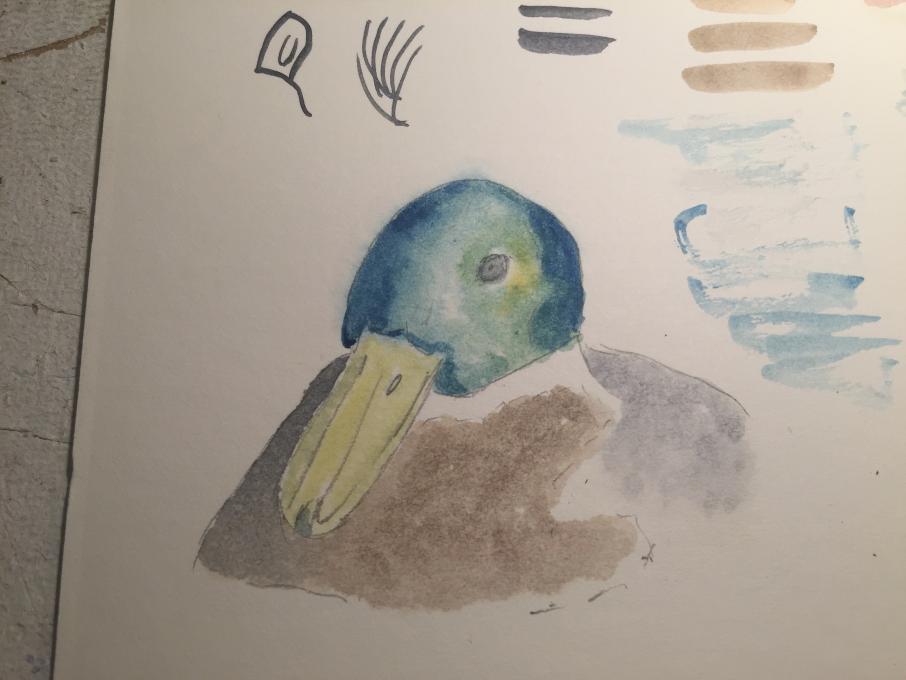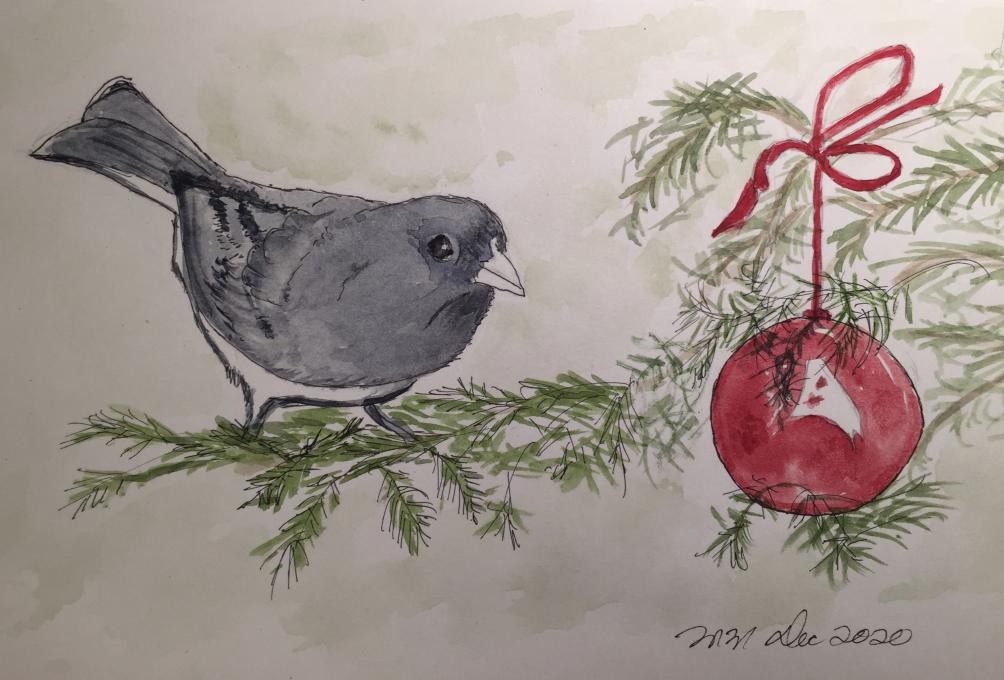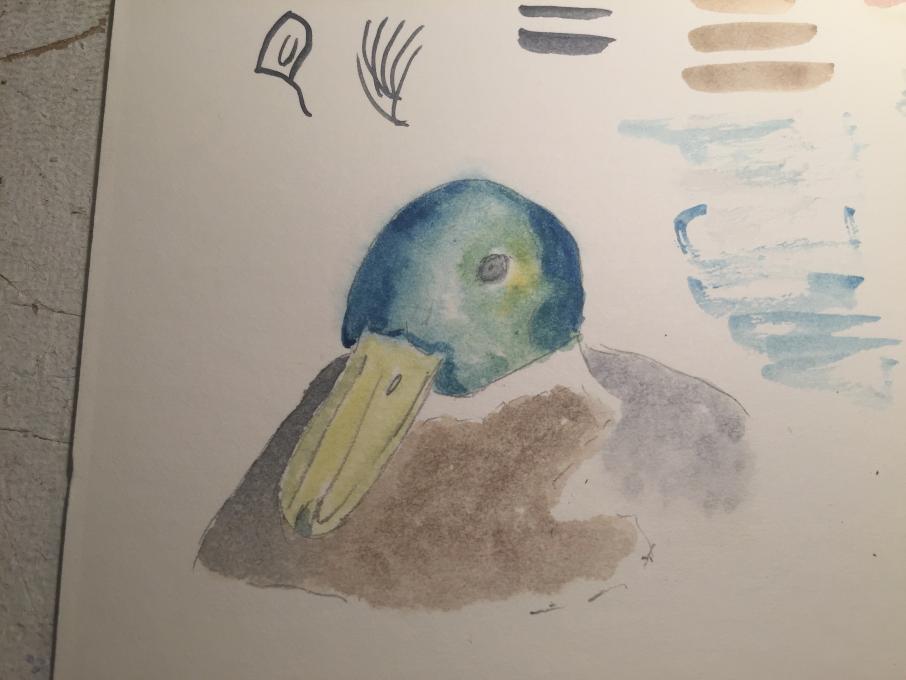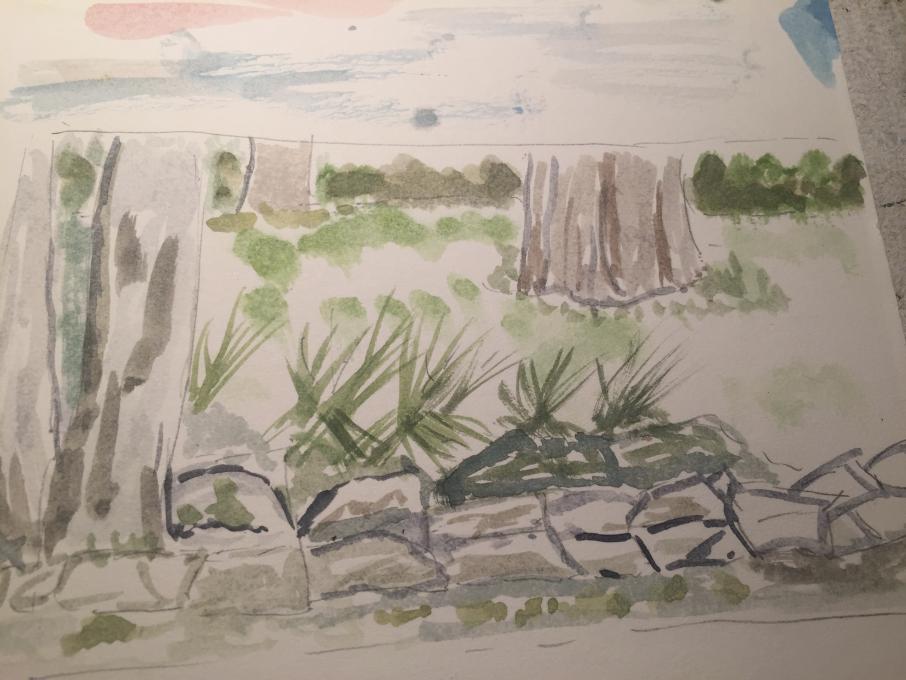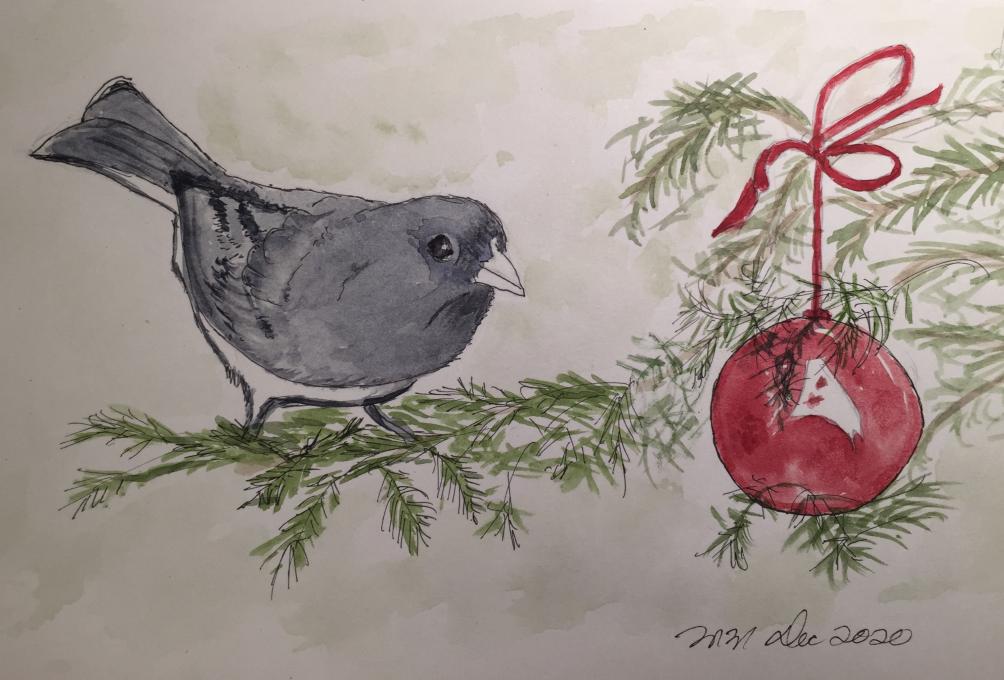The Cornell Lab Bird Academy › Discussion Groups › Nature Journaling and Field Sketching › Getting Comfortable with Watercolor
-
I tried all three techniques in these paintings. I have the most difficulty with the wet on wet. I want to control the paint too much
 and then I go over the wet area with more paint and water. Before I know it I am lifting the paper.
and then I go over the wet area with more paint and water. Before I know it I am lifting the paper. -
 I tried each of the three techniques in the pages above. I really liked using the wet on dry for getting in the fine details on the snowy owl. I also loved using wet on wet to get a pretty good representation of the sunset. Still struggle with dry brush a bit for texture as it is difficult to control. I actually used a dry natural sponge to try to get the texture of the lichens. Closer-- but still not quite there....
I tried each of the three techniques in the pages above. I really liked using the wet on dry for getting in the fine details on the snowy owl. I also loved using wet on wet to get a pretty good representation of the sunset. Still struggle with dry brush a bit for texture as it is difficult to control. I actually used a dry natural sponge to try to get the texture of the lichens. Closer-- but still not quite there.... -
I really like how the dry natural sponge added texture.
-
-
Two of the three techniques are used here. The color intensity on the other students' paintings below is inspiring. Going with lighter values forced me to paint multiple layers which looks overworked. The sky was painted twice and most of the grass three times! I miss Tiaki on the Royal Albatross Cam but am having fun painting her!

-
This is gorgeous! I love watching the live animal webcams too. Love your shading and shadows in the white. You are obviously an experienced artist and know how to use value intensity very effectively.
-
-
I tried 3 of them. Wet on dry is definitely my favorite. Also, it's a bit hard for me to use the water brush. I was very frustrated and my hand was getting tired squeezing the water. I ended up getting two jars and I painted happily.
-
I have tried all three water brush techniques and I prefer the dry on dry because of the control. The other two techniques were unpredictable and the wet on dry did not have the control I desire. I have difficulty with the water brush techniques which I do appreciate but, have not had the success that I had with gouache technique where I used brushes with pigments and water. As with any new technique, I will keep working with it and may find success with the right subjects. The second image is of a dragonfly with gouache. tecnique.


-
I tried all 3. Ive loved the colors I got from wet on wet, but they were much lighter than I wanted. I then tried letting the paper dry and going in with a wet-dry technique. That was only partially successful. The Dry on dry was fun but I didn't have much control. I guess all these techniques require lots of practice :). I can see using all 3 tecniques in my Nature Journal,
-
My wet on wet, dry on wet, and wet on dry palm
-

-
It was fun to try put these techniques, there is now so much more to learn and experiment with! I rushed the duck reflection, I think even a casual looking painting needs lots of care !


-
Just as everyone else has said, it seems wet on wet is better for large, more diffuse coloring. Dry on wet tends to be easier to control. For me the dry on dry was the most challenging. I still think my brush just gathers too much 💧. This I need to practice much more. It does help to know I can always go back and add more detail. Yet trying to fix a wet on wet with more wet just made a mess.



-
 8
8 -
I use to shy away from using the wet on wet technique and disliked watercolors for a long time because of the lack of control. I have been experimenting with wet on dry and dry brush these past few months and finding watercolors much more enjoyable to work with. I like the idea of using wet on wet for the sky or water or larger areas. I just have to remember to be patient and let it dry thoroughly before moving to more detailed work.
-
I am familiar with wet on dry and wet on wet. I tried both techniques and the key issue is control of the water, especially letting it dry before adding anything next to it or the colour will run. It is very unforgiving, especially wet on wet. Using a dry brush was a new technique (I have only done this accidentally in the past) and gives a useful effect, which may be useful for bark etc.
-
This was very informative. Still having a hard time with dry on dry, but it gave me a better idea of how to handle the medium and what technique works best in different scenarios.
-
I applied all the techniques to get the feel of them. I'm familiar with them, yet i discovered that dry brushing techniques add texture to rough surface. Adding color and sweeping the edges is a technique I would like to share because it helps define the edges and give the shape a nice tidy look. For future journaling, I feel much more confident to apply the glazes over added color to mute it down. Following the drawings shared, they helped to implement the techniques and compare with the drawings. Thank you. Below are the practice drawings I did. It took a long time, but was fun.



-
I tested out all of these techniques. I can see that the wet on wet would be great for backgrounds, but it's kind of unforgiving. I wonder if it dried, if I could do a wet on dry over it. I am going to need more practice to master the texture of dry on dry with a water brush. In the future, I will try the wet on dry for detail work and dry on wet for large areas of color.
-
I have tried all three techniques. Wet on dry offers more options for control . It is direct painting. You make your mark in the spot where you want it to be. You have to pay more attention to what is happening with wet on wet because the colors can mix or go in direction that you might not want them to go. It can be challenging. I really like the textured look that you can achieve with dry brush on dry paper. For instance you can make a field of grass without making a brush stroke for each blade of grass.
-
I'm having fun blending colors. I was glad to learn the 3 techniques today as that will give me more control over my brush.
-
 I enjoyed this! I love seeing the Canada Geese at a park on a river where I live. This little painting is from one of my photos. I took some artistic liberties with colors. I decided to give everything a bluer, cooler tint - so I started with a blue tone to the white on the goose to take the edge off the ivory toned watercolor paper. Then, I added blue to the black for the head & neck and blue to a dark cool brown for the body. I decided to use the same Ultramarine Blue in the water as well, which was actually a Cerulean Blue in the photo. I neutralized the Ultramarine Blue with a yellowish orange so the water would recede and the goose would be more of the focus. For all this I worked wet on dry, but I wasn't sure if that was right - maybe I should have wet down the paper first for the water. There are some slightly mottled areas, but I got lucky and they look a little like ripples in the water (LOL). I worked wet on wet for the goose's reflection in the water, but then it wasn't dark enough, so I worked dry brush over it to create dark ripples in the water. It unfortunately lost some of the luminosity from wet on wet as a result, but I think it still looks somewhat like a reflection.
I enjoyed this! I love seeing the Canada Geese at a park on a river where I live. This little painting is from one of my photos. I took some artistic liberties with colors. I decided to give everything a bluer, cooler tint - so I started with a blue tone to the white on the goose to take the edge off the ivory toned watercolor paper. Then, I added blue to the black for the head & neck and blue to a dark cool brown for the body. I decided to use the same Ultramarine Blue in the water as well, which was actually a Cerulean Blue in the photo. I neutralized the Ultramarine Blue with a yellowish orange so the water would recede and the goose would be more of the focus. For all this I worked wet on dry, but I wasn't sure if that was right - maybe I should have wet down the paper first for the water. There are some slightly mottled areas, but I got lucky and they look a little like ripples in the water (LOL). I worked wet on wet for the goose's reflection in the water, but then it wasn't dark enough, so I worked dry brush over it to create dark ripples in the water. It unfortunately lost some of the luminosity from wet on wet as a result, but I think it still looks somewhat like a reflection. -
It is beautiful. It would be interesting to see it with the water done wet on wet.
-
-
Fun! I'm having some trouble with the dry brush technique, the brush really does retain a lot of water. There is a lot of waiting involved in many of these which requires some getting used to, but the watercolor is really fun and rewarding when you get it right!
-
I had difficulty with mixing the colors. The watercolor technique which was the most familiar and, therefore, seemed the easiest was the "wet on dry". I practiced with varied wetness of the brush and was able to see the changes in color when a new color was added. But, I will need a lot of practice not to over the brush. The wet on wet was "awash out" literally and figuratively. It was most difficult to use when mixing colors. As for the "dryon dry", it was quickly apparent how texture could be developed in a picture. Do you use all 3 in a painting?
-
I did the same painting using the three different techniques and for this one I think the wet on wet turned out best, but in general for nature journaling I prefer the wet on dry. I still have to work on the dry on dry technique.
 Really fun activity!
Really fun activity! -
I had most success with wet on dry and layering, requiring dry time. Can the mixed paints sit in the pallette for a day or so? Seems difficult to recreate the same color mixes. I feel that my wet on wet and dry on dry skills need more practice. I would like make better impressions of
 snow, water, and sky using wet on wet.
snow, water, and sky using wet on wet. -
I have been trying to make a xmas card recently and have used both wet on wet and dry brush. I like both techniques and have always used them in the past. Wet on wet is hard in that you have to have the paper just wet the right amount or it becomes dry before you want it to. With dry brush or dry brush on wet, if you make a mistake you can't correct it. I enjoyed wet on wet copying the Mallard, its fun to see how it works. You can't go too wrong as there are no hard lines. I find that if I just use a wet brush on dry my photo is a bit messy looking. It's harder to make it look natural.



-
I was working on this Junco for a xmas card and used both wet on wet and dry brush techniques. I like using both together. When I just use dry brush, it tends to get messy looking. See the example of the garden scene. Wet on wet isn't easy either because if the paper dries and you don't notice, the paint forms a hard edge where you don't want it to. I enjoyed working on the mallard using wet on wet. I like doing flowers wet on wet too.



Read More:
 and then I go over the wet area with more paint and water. Before I know it I am lifting the paper.
and then I go over the wet area with more paint and water. Before I know it I am lifting the paper.  I tried each of the three techniques in the pages above. I really liked using the wet on dry for getting in the fine details on the snowy owl. I also loved using wet on wet to get a pretty good representation of the sunset. Still struggle with dry brush a bit for texture as it is difficult to control. I actually used a dry natural sponge to try to get the texture of the lichens. Closer-- but still not quite there....
I tried each of the three techniques in the pages above. I really liked using the wet on dry for getting in the fine details on the snowy owl. I also loved using wet on wet to get a pretty good representation of the sunset. Still struggle with dry brush a bit for texture as it is difficult to control. I actually used a dry natural sponge to try to get the texture of the lichens. Closer-- but still not quite there.... 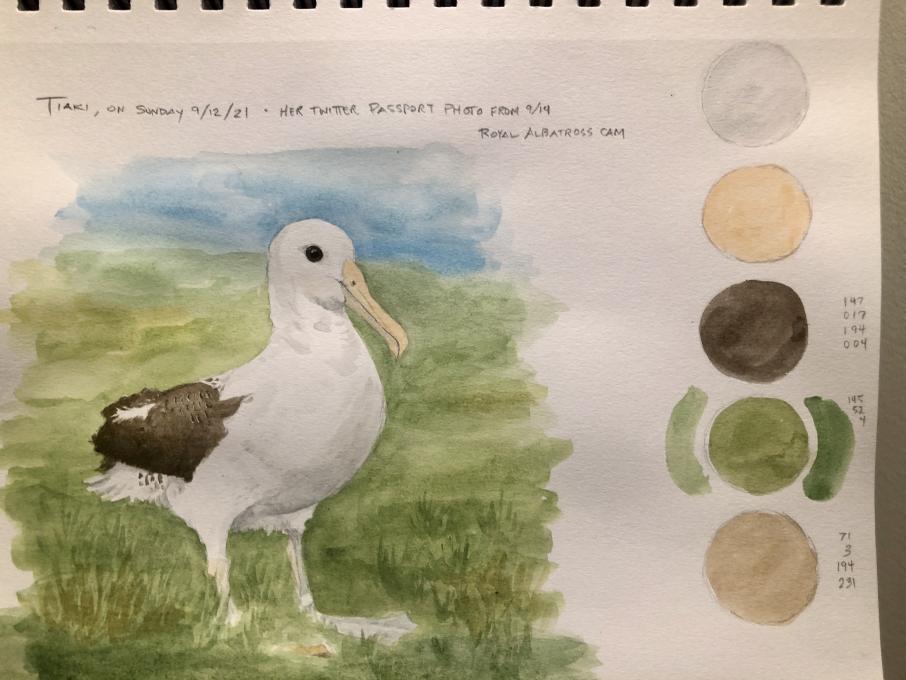
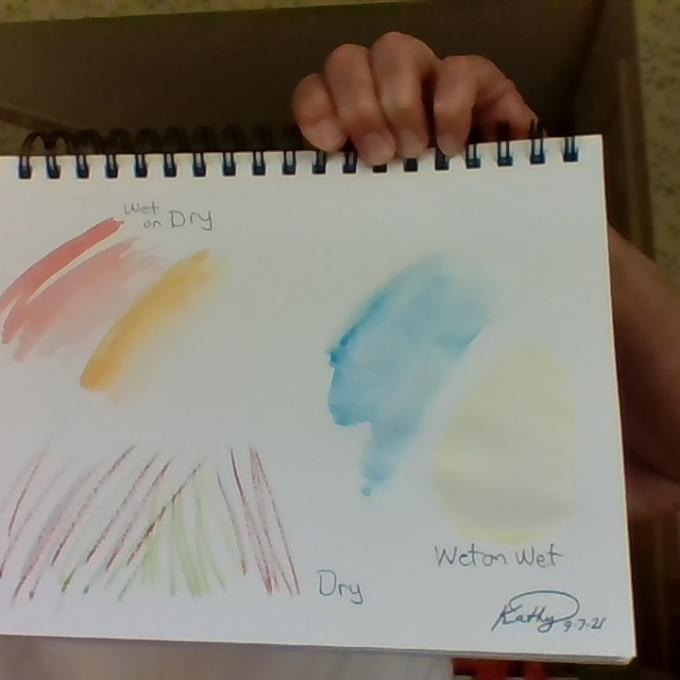
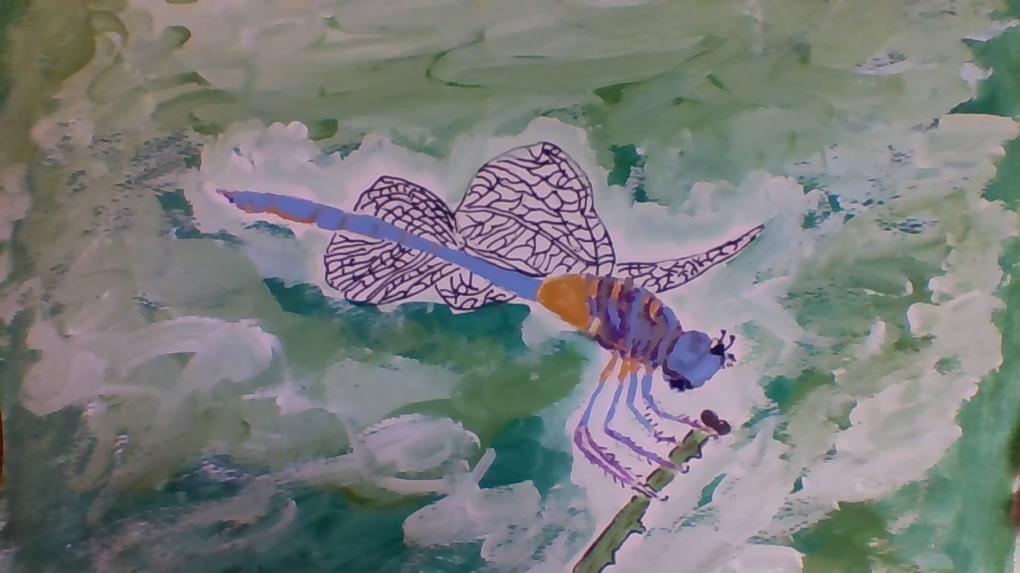
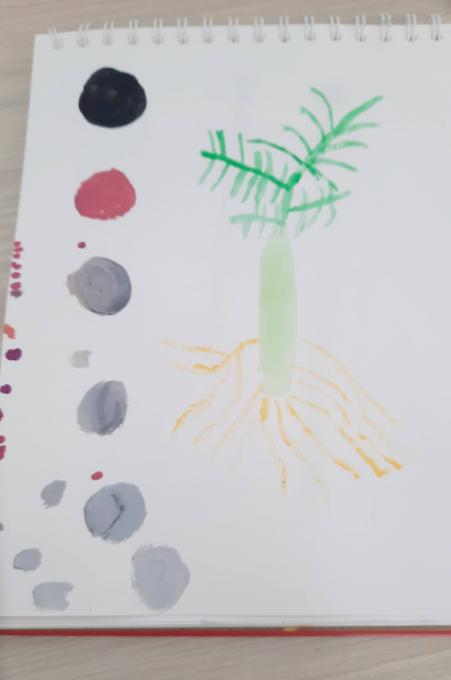
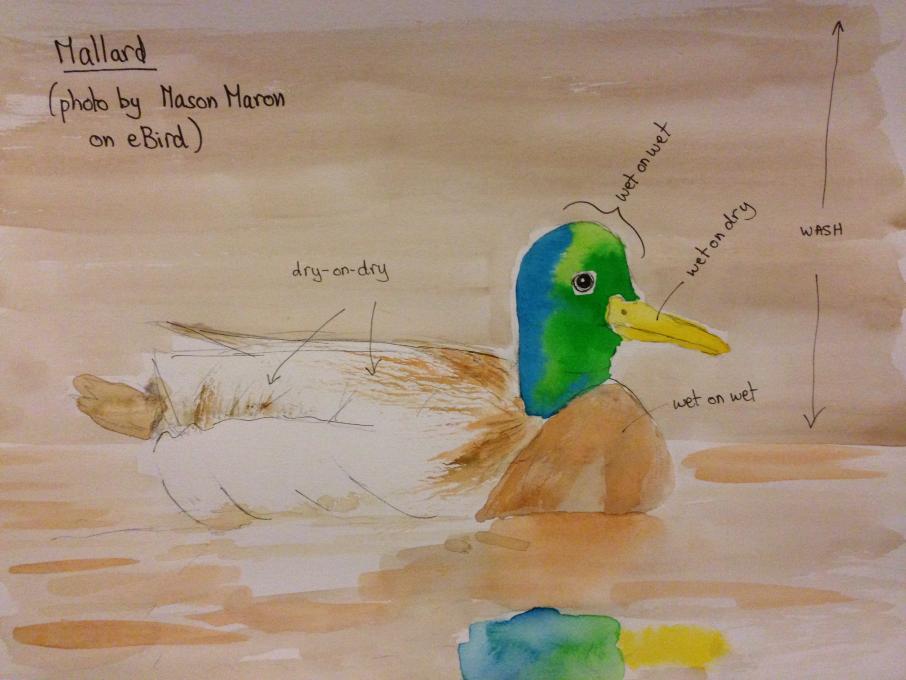
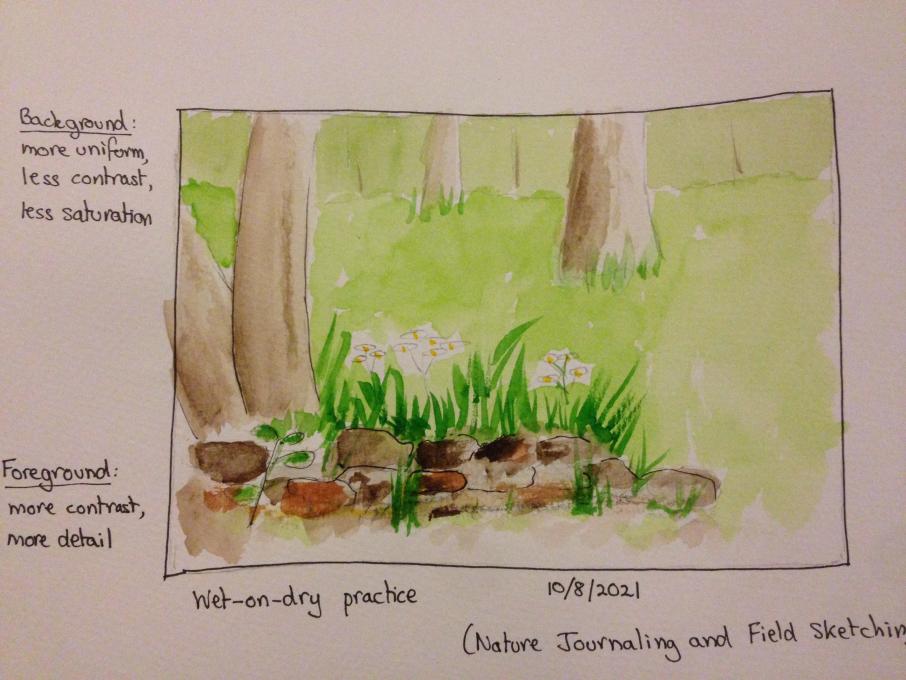

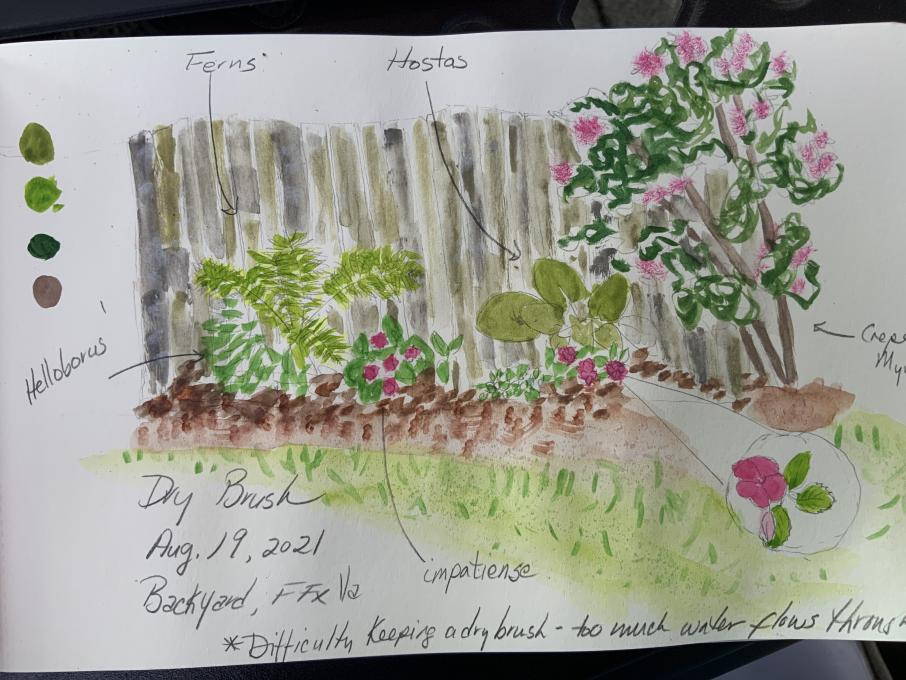
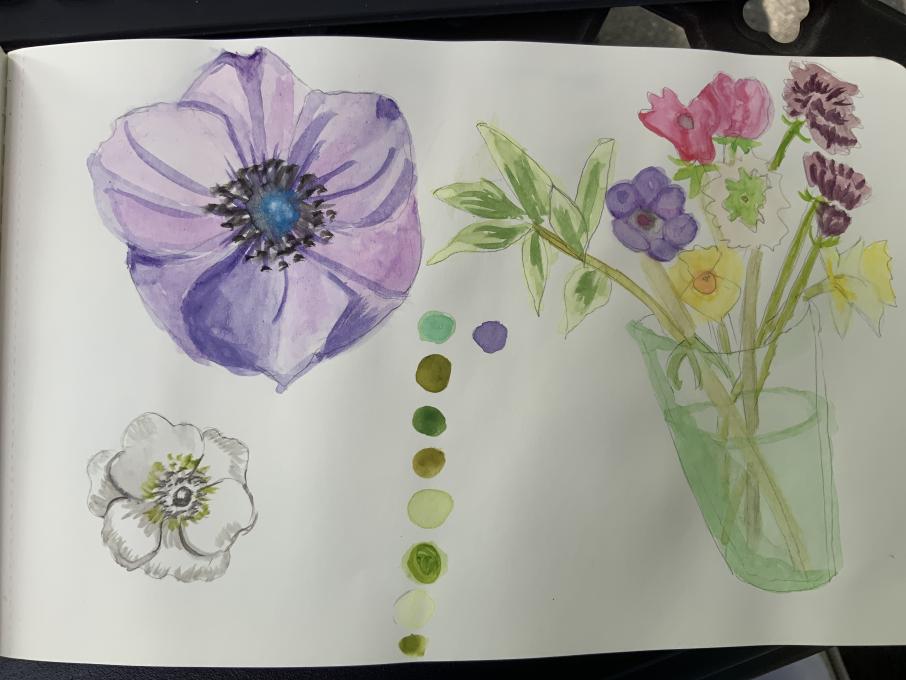
 8
8 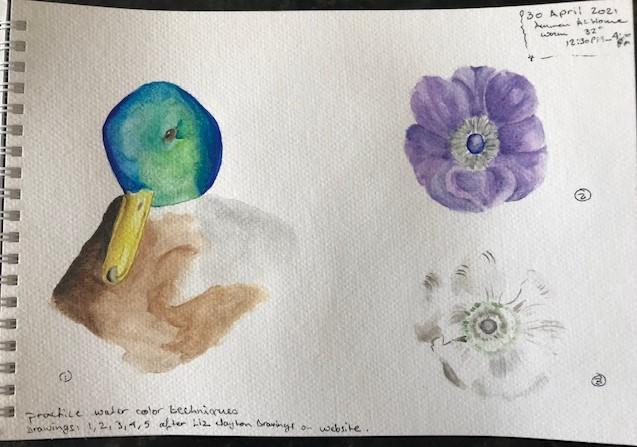

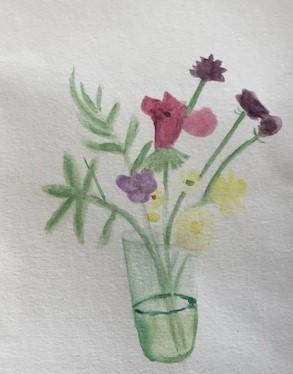
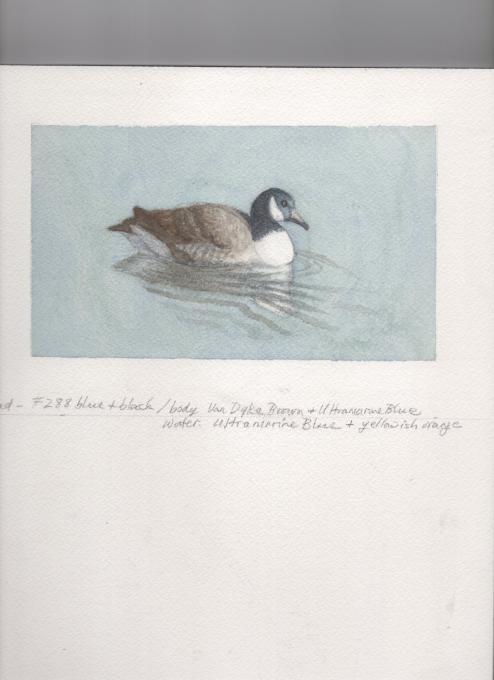 I enjoyed this! I love seeing the Canada Geese at a park on a river where I live. This little painting is from one of my photos. I took some artistic liberties with colors. I decided to give everything a bluer, cooler tint - so I started with a blue tone to the white on the goose to take the edge off the ivory toned watercolor paper. Then, I added blue to the black for the head & neck and blue to a dark cool brown for the body. I decided to use the same Ultramarine Blue in the water as well, which was actually a Cerulean Blue in the photo. I neutralized the Ultramarine Blue with a yellowish orange so the water would recede and the goose would be more of the focus. For all this I worked wet on dry, but I wasn't sure if that was right - maybe I should have wet down the paper first for the water. There are some slightly mottled areas, but I got lucky and they look a little like ripples in the water (LOL). I worked wet on wet for the goose's reflection in the water, but then it wasn't dark enough, so I worked dry brush over it to create dark ripples in the water. It unfortunately lost some of the luminosity from wet on wet as a result, but I think it still looks somewhat like a reflection.
I enjoyed this! I love seeing the Canada Geese at a park on a river where I live. This little painting is from one of my photos. I took some artistic liberties with colors. I decided to give everything a bluer, cooler tint - so I started with a blue tone to the white on the goose to take the edge off the ivory toned watercolor paper. Then, I added blue to the black for the head & neck and blue to a dark cool brown for the body. I decided to use the same Ultramarine Blue in the water as well, which was actually a Cerulean Blue in the photo. I neutralized the Ultramarine Blue with a yellowish orange so the water would recede and the goose would be more of the focus. For all this I worked wet on dry, but I wasn't sure if that was right - maybe I should have wet down the paper first for the water. There are some slightly mottled areas, but I got lucky and they look a little like ripples in the water (LOL). I worked wet on wet for the goose's reflection in the water, but then it wasn't dark enough, so I worked dry brush over it to create dark ripples in the water. It unfortunately lost some of the luminosity from wet on wet as a result, but I think it still looks somewhat like a reflection. 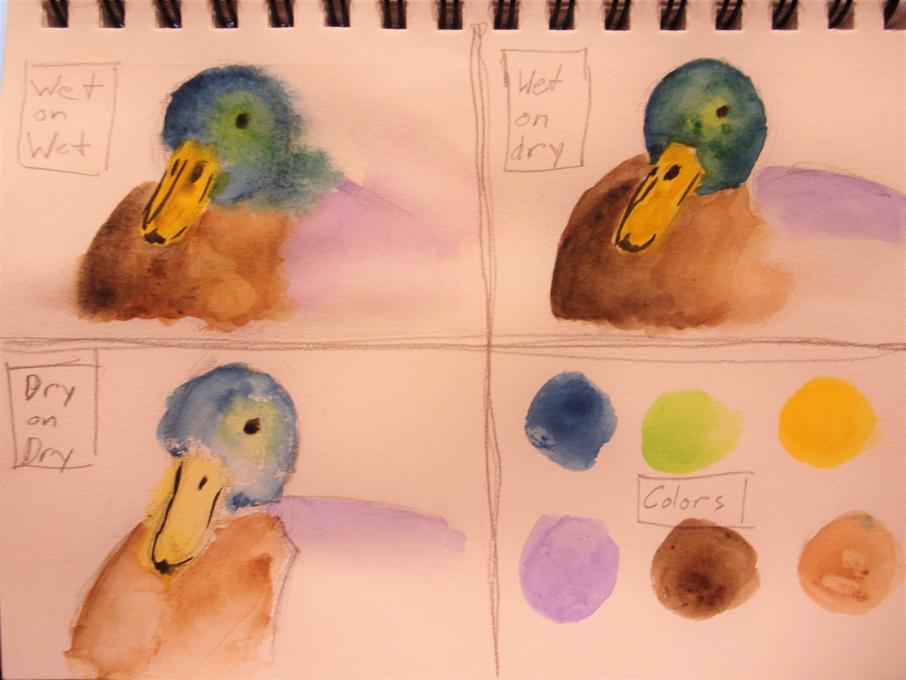 Really fun activity!
Really fun activity!  snow, water, and sky using wet on wet.
snow, water, and sky using wet on wet. 